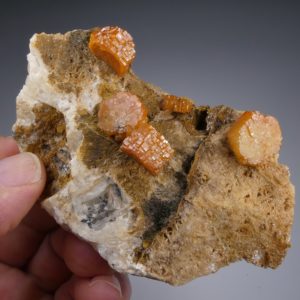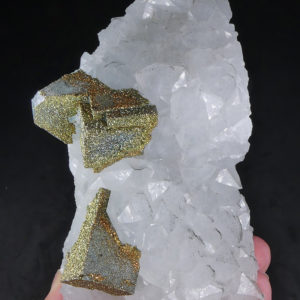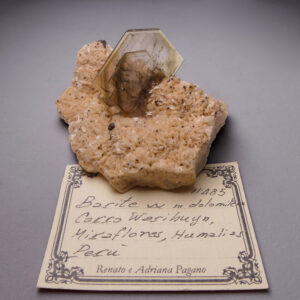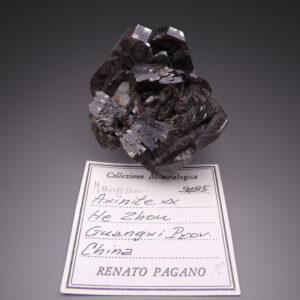REALGAR, CALCITE – China – GFS0428
In stock
€ 600,00 +TAX
Realgar, Calcite
Jiepaiyu Mine, Shimen deposit, Shimen Co., Changde, Hunan, China
15,5×10,5×10 cm. (main Calcite 7,2×5,3×3 cm.)
This specimen, of considerable size, features two main bright and well-formed Calcite crystals, internally ranging from transparent to translucent, aesthetically arranged in opposite positions and emerging from a bed of small and shiny crystals with a pinkish hue, caused by both surface presence and inclusions of Realgar and Orpiment. Around the matrix, other intensely colored areas are clearly visible, indicating the presence of Realgar and Orpiment in compact masses. An excellent example of this highly sought-after mineral association at a truly affordable price.
Realgar is a mineral composed primarily of arsenic sulfide (As₄S₄), not stable when exposed to light and air over time, slowly transforming into pararealgar or other arsenic oxides, losing its vibrant color. It most commonly occurs as a low-temperature hydrothermal vein mineral combined with other arsenic and antimony minerals, normally found in association with Orpiment, Arsenolite, Barite and Calcite; highly sought after and aesthetic are the associations with Calcite, primarily coming from Hunan province in China. It also occurs as volcanic sublimations and in hot spring deposits.
It has been known and used for thousands of years, playing various roles throughout history due to its vivid red-orange color and toxic properties.
The name “realgar” comes from the Arabic phrase “rahj al-ghār”, which means “powder of the cave.” This is likely because it was often found in caves or underground mines and easily reduced to powder form. The term made its way into Latin and then into modern scientific vocabulary. Ancient Egyptians and Chinese used realgar for medicinal purposes, despite its toxicity. In China, it was used as a pesticide and to repel snakes, associated with protection and mixed into wine during the Dragon Boat Festival to ward off evil spirits and diseases; also used to poison rats in medieval Spain and in 16th century England.
Realgar was widely used as a pigment in medieval manuscripts, frescoes and paintings during the Renaissance period. Its brilliant red-orange color was prized, but over time, it tends to darken or degrade, sometimes turning into pararealgar, a yellowish substance, thus decreeing his decline in popularity.
Modern use has declined due to its toxicity, however, it is still studied for its chemical properties and has niche applications in chemical research. Occasionally, it’s used in certain pyrotechnics for special effects.
In stock
Additional information
| Weight | 1.011 kg |
|---|---|
| Dimensions | 15.5 × 10.5 × 10 cm |
| Country | |
| Location | |
| Species |

























 BARYTE, DOLOMITE - Perù - GFS0475
BARYTE, DOLOMITE - Perù - GFS0475  SCORODITE - China - GFS0469
SCORODITE - China - GFS0469  TOURMALINE - Madagascar - GFS0024
TOURMALINE - Madagascar - GFS0024  AXINITE - China - GFS0476
AXINITE - China - GFS0476  REALGAR, CALCITE - China - GFS0428
REALGAR, CALCITE - China - GFS0428  KARIBIBITE, LOLLINGITE - Morocco - GFS0474
KARIBIBITE, LOLLINGITE - Morocco - GFS0474  COPPER - U.S.A. - GFS0015
COPPER - U.S.A. - GFS0015  UVAROVITE garnet - Russia - GFS0029
UVAROVITE garnet - Russia - GFS0029  SPESSARTINE, PYRITE - China - GFS0069
SPESSARTINE, PYRITE - China - GFS0069